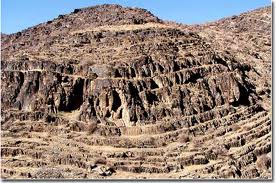Sarmysh gorge
Navoi Sarmysh gorge, the area of the massif Bukantau is located near Navoi city. At the end of the 80-s of the 20th century there were rumours in this region, that UFO accidents occurred in Sarmysh gorge.
Sarmysh gorge, the area of the massif Bukantau is located near Navoi city. At the end of the 80-s of the 20th century there were rumours in this region, that UFO accidents occurred in Sarmysh gorge.
The scientific expedition immediately flew to the site of occurrence. The researchers made the great and laborious task, but no remains of the UFO were found.
However, the expedition was not entirely fruitless. In the gorge Sarmysh many ancient rock paintings were discovered by scientists. Among these pictures there were very unusual examples. People alike aliens in obscure outfits resembling spacesuits were depicted on the paintings. The researchers suggest that the age of the patterns is ten or fifteen thousand years. The scientists already found something like this in the caves in China and Spain. But there were not so many petroglyphs anywhere like in the gorge Sarmysh. In the scientific world this gorge was recognized the biggest rock art gallery in the world. On the territory of two kilometers there are four thousand of petroglyphs, which are engraved on the black shale. The first petroglyphs were created during the late Stone Age, and the youngest are dated to the Middle Ages.
Sarmysh gorge is located in Karatau ridge between Navoi and Nurata cities not far from the mountain pass Kara-Karga. The appearance of mysterious and majestic mountain range, promises to even the most experienced traveler the meeting with a mystery.
The birth of this culture happened approximately in the late Stone and Bronze Ages.
Favorable nature conditions favoured the successful development of this civilization.
 High-water mountain rivers attracted many wild animals from deserts. That is why local ancient people had no problems with hunting. Caucasian goats, moufflons, oxen and deer were the hunters’ bag. Plenty of caves, which could be easily adapted for dwellings in winter, helped ancient people to change nomadic life into the settled way of life. People began to develop farming, they learned how to work metals. In short they began to live comfortably.
High-water mountain rivers attracted many wild animals from deserts. That is why local ancient people had no problems with hunting. Caucasian goats, moufflons, oxen and deer were the hunters’ bag. Plenty of caves, which could be easily adapted for dwellings in winter, helped ancient people to change nomadic life into the settled way of life. People began to develop farming, they learned how to work metals. In short they began to live comfortably.
All rock paintings, which were found in Sarmysh gorge, are notable for their story line, styles and executions.
One part of petroglyphs was painted with the sienna, mixed with the fat. And some petroglyphs were, perhaps, knocked out with the metallic instruments on the smooth slate rock surface.
The earliest paintings were created in the 9th millennium BC. Primitive hunters, surrounded by wild and predatory animals, were depicted on rock paintings. Late petroglyphs are filled with ritual and everyday scenes from the life of ancient people. Mainly, domestic animals were depicted. Among them there were many dogs, sheep and camels. Striking is the fact that it was possible to see three humped camels on the pictures.
On some petroglyphs one can see the figures of the abstract form, the origin of which is unknown. The researches suppose that these signs are of religious sense.
More “modern” Scythian petroglyphs depict armed fighters and rulers.
And the youngest images refer to the period of the 18th century AD. From the beginning of the 12th century Sufi dervishes settled in the cave. That is why the Arabic ligature was seen on the last petroglyphs. The Arabic character tells us about the life of dervishes and their followers.
The researches, engaging in study of rock paintings in Sarmysh gorge, say, that they did not meet repeated or identical petroglyphs among four thousand stone pictures. Each petroglyph is unique.
The images of so called cosmic aliens – two headed man figures in space suits, take a special place among rock paintings of the cave. These petroglyphs attract the attention of many curious tourists.
The most attractive in this area is that in our days the gorge appears in front of our views as pure as it was in ancient times, at the dawn of civilization.
So, the study of anomalies, secrets and mysteries of Sarmysh gorge is in progress even today. It is possible that soon there will be new hypotheses and answers to available questions.
